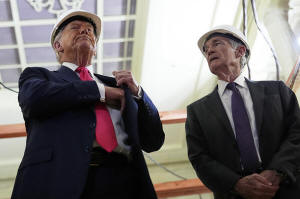Federal Reserve likely to stand pat on rates this week, deepening the
gulf between Powell and Trump
[July 29, 2025] By
CHRISTOPHER RUGABER
WASHINGTON (AP) — The Federal Reserve is expected to leave its
short-term interest rate unchanged on Wednesday for the fifth straight
meeting, a move that will likely underscore the deep divide between how
Chair Jerome Powell and his chief critic, President Donald Trump, see
the economy.
The Fed itself, to be sure, is increasingly divided over its next steps,
and many economists expect that two members of the Fed's governing board
— both appointed by Trump — could dissent on Wednesday in favor of
cutting rates. If so, that would be the first time two governors vote
against the chair since 1993.
Even so, the gap between the views of the Fed's interest-rate setting
committee, chaired by Powell, and the White House is unusually large. In
several areas, Trump's views sharply contrast with that of the Fed's
leadership, setting up likely clashes for years to come, even after
Powell's term as chair ends in May 2026.
For example, Trump says that because the U.S. economy is doing well, the
Fed should cut rates, as if the U.S. is a blue-chip company that should
pay less to borrow than a risky start-up.
But Fed officials — and nearly all economists — see it the other way: A
solid economy means rates should be relatively high, to prevent
overheating and a burst of inflation.

“I’d argue that our interest rates are higher because our economy’s
doing fairly well, not in spite of it,” said Gennadiy Goldberg, head of
U.S. rates strategy at TD Securities.
Trump argues that the Fed in general and Powell in particular are
costing U.S. taxpayers hundreds of billions of dollars in interest
payments by not reducing borrowing costs. Yet Fed officials don't think
it's their job to reduce rates the government pays on Treasury notes and
bonds.
Most economists worry that if they did, they would risk failing at one
of the key jobs Congress gave them: fighting inflation.
“It’s using monetary policy to ease pressure on fiscal policymakers, and
that way points to higher inflation and bigger problems down the road,"
said William English, an economist at the Yale School of Management and
former senior Fed staffer.
If financial markets see that the Fed is focused on keeping borrowing
costs low to help the government — rather than focusing on its
congressionally-mandated goals of stable prices and maximum employment —
Wall Street investors, worried about future inflation, will likely
demand higher interest rates to hold Treasury bonds, economists say,
pushing up borrowing costs across the economy.
For his part, Trump says there is “no inflation” and so the Fed should
reduce its short-term rate, currently at about 4.3%, which was ramped up
in 2022 and 2023 to fight rising prices. The Fed’s rate often — but not
always — influences longer-term borrowing costs for mortgages, car
loans, and credit cards.
Inflation has fallen sharply and as a result Fed officials have signaled
they will cut rates by as much as a half-percentage point this year. Yet
it has picked up a bit in the last two months and many of those
policymakers, including Powell, still want to make sure that tariffs
aren't going to lift inflation much higher before they make a move.
Inflation accelerated to 2.7% in June from 2.4% in May, the government
said earlier this month, above the Fed's 2% target. Core prices, which
exclude the volatile food and energy categories, rose to 2.9% from 2.8%.
[to top of second column] |

President Donald Trump, left, reaches for a document of cost figures
as Federal Reserve Chairman Jerome Powell watches during a visit to
the Federal Reserve, Thursday, July 24, 2025, in Washington. (AP
Photo/Julia Demaree Nikhinson)
 Last week, Trump and several White
House officials ramped up their attacks on Powell over rates. They
also criticized the ballooning costs of the Fed's renovation of two
of its buildings, raising questions over whether the president was
looking to fire Powell for cause rather than policy differences.
Trump and Powell engaged in an extraordinary
on-camera confrontation over the cost of the project during Trump's
visit to the building site last Thursday. On Monday, Trump was more
restrained in his comments on the Fed during a joint appearance in
London with British Prime Minister Keir Starmer.
"I’m not going to say anything bad,” Trump said. “We’re doing so
well, even without the rate cut.”
But he added, “a smart person would cut."
Some economists expect that the Fed will reduce its key rate by a
quarter-point in September, rather than July, and say that the
two-month delay will make little difference to the economy.
Yet beyond just the timing of the first cut, there is still a huge
gulf between what Trump wants and what the Fed will even consider
doing: Fed officials in June penciled in just two reductions this
year and one in 2026. They forecast that their key rate will still
be 3.6% at the end of next year. Trump is pushing them to cut it to
just 1%.
“That's not going to happen with anything like the current people on
the committee,” English said.
Wall Street investors also expect relatively few cuts: Two this year
and two in 2026, according to futures pricing tracked by CME's
Fedwatch.
According to the Fed's projections, just two officials in June
supported three cuts this year, likely Trump's appointments from his
first term: governors Christopher Waller and Michelle Bowman.

Waller gave a speech earlier this month supporting a rate reduction
in July, but for a very different reason than Trump: He is worried
the economy is faltering.
“The economy is still growing, but its momentum has slowed
significantly, and the risks” of rising unemployment “have
increased,” Waller said.
Waller has also emphasized that tariffs will create just a one-time
bump in prices but won't lead to ongoing inflation.
Yet most Fed officials see the job market as relatively healthy —
with unemployment at a low 4.1% — and that as a result, they can
take time to make sure that's how everything plays out.
“Continued overall solid economic conditions enable the Fed to take
the time to carefully assess the wide range of incoming data,” said
Susan Collins, president of the Boston Federal Reserve. “Thus, in my
view, an ‘actively patient’ approach to monetary policy remains
appropriate at this time.”
All contents © copyright 2025 Associated Press. All rights reserved |